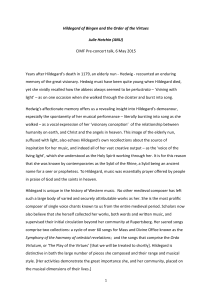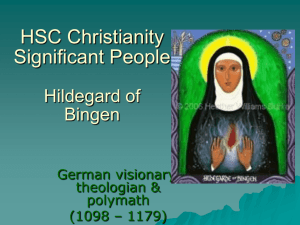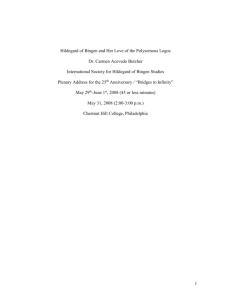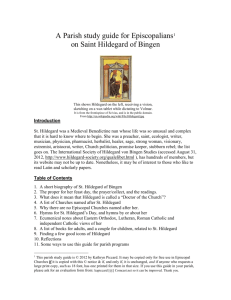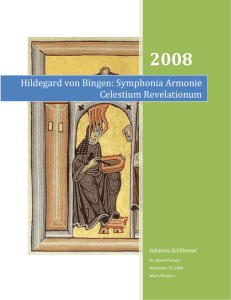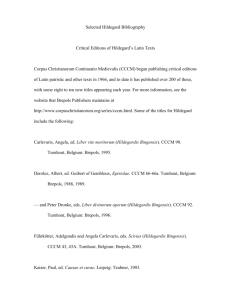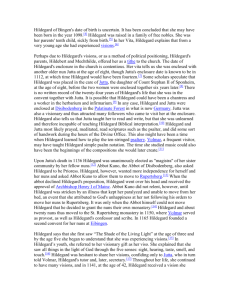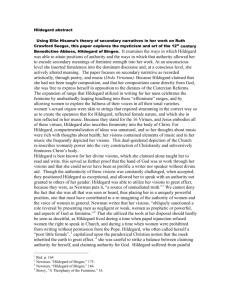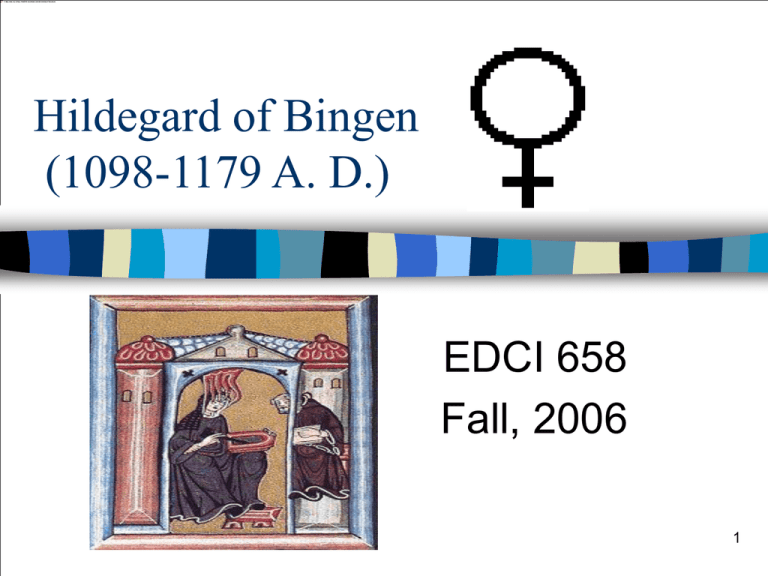
Hildegard of Bingen
(1098-1179 A. D.)
EDCI 658
Fall, 2006
1
Hildegard’s Life and Times
Born around 1098 in Bermersheim, Germany
She was the tenth or last child of a knight
family
When she was fifteen, she took her vows as a
Benedictine nun
She was considered “uneducated” because
of lack of formal schooling in grammar,
rhetoric, and dialectic even though her writing
reflected a deep knowledge of Scriptures and
main Christian writers of her time and of
classical literature
2
Hildegard’s Life and Times
Led a structured convent life
Worked as a nurse-physician for years;
experimented her own herbs
Jutta, her mentor died when Hildegard was
38 years old and was appointed abbess of
the nuns
She recalled in her writing that she had
experienced visions and divine revelations
since 3 years of age
Her spiritual director and confessor, Volmar, a
Benedictine monk, became her secretary, and
encouraged her to write down her visions
3
Hildegard’s Life and Times
Wrote six major works, nearly 400 letters, and
80 songs
Scivias (Know the Ways of God) her most
famous book, written in imaginary manner,
conveyed the knowledge an individual needs
in order to achieve salvation
Hildegard was corresponding with many
prominent people at her time, including kings
and popes
She compiled two substantial scientific works:
Physica (plants, trees, and herbs) and
Causae at Curae (leprosy, scabies, lice,
burns, allergies)
4
Hildegard’s Life and Times
Some musicologists designated Hildegard as
first women composer (others designated
Sappo)
She has to discipline, advise, and teach the
nuns, administrate supplies of food, clothing,
fuel, receiving guests, attend to legal business,
and supervise work on convent land including
cooking and cleaning
Her relationship with the nuns in her convent
was characterized as an “mentoring” relationship
She received Pope’s sanction to travel lecturing
Christian faith at a time of the Papal Schism
(Victor IV and Alexander III)
5
Hildegard’s Biographers
After Volmar died, Gottfried was
appointed as his successor and began
to write on the life of Hildegard
Hildegard’s brother Hugh took over the
biography after Gottfried died as well
Finally, French monk Guilbert of
Gembloux took over the biography and
served as Hildegard’s secretary after
Hugh died eventually as well
6
Hildegard’s Biographers
“Hildegard was a mother to the nuns,
exercising great affection and virtue with
them. They honored and obeyed
her…Hildegard pours herself out all in charity,
giving counsels required of her, solving the
most difficult questions put to her, writing
books, instructing her sisters, putting fresh
heart into the sinners who approach her. She
is wholly taken up by it all even though she is
old and infirm”
– Guilbert cited in Murphy, 2006, p. 106
7
Hildegard’s Importance in Education
Only women in her time accepted as an
authoritative voice on Christian doctrine
Permitted to write theological books and
lecture to clergy and laity by the Pope
First women to write on natural science,
medicine, and sexuality
An artist, composer, and prolific author with
great talent
First philosopher to articulate a theory of sex
complementarities; equal yet different
8
Hildegard’s Importance in Education
She believed women ought not be limited to
the private sphere of activity or, inversely, that
the public sphere ought not be limited to men
Claimed women were called to prophesize
because men had become weak or immoral
She also disagreed with the view of her time
that education should only hand down the
past knowledge. She believed that education
is an opportunity to discover new
perspectives of art, divine truth, and culture
She is an transition figure of the Medieval
Ages, who made it possible for women to
9
purse university studies later on
Excerpts from Hildegard’s Writings
“A human being contains three paths;
namely, soul, body and senses. On these
three paths, human life runs its
course…The soul provides the body with
life, like fire flooding the darkness with
light; it has two major powers life two arms:
the understanding and the will…Therefore
human being, you are not a bundle of
veins; pay attention to the knowledge of
the scriptures”
– Cited in Murphy, 2006, p. 110
10
Resources about Hildegard
http://www.fordham.edu/halsall/med/hildegard
e.html
http://home.infionline.net/~ddisse/hildegar.ht
ml
http://www.newadvent.org/cathen/07351a.htm
http://www.healingchants.com/hvb_links.html
http://www.medieval.org/emfaq/composers/hil
degard.html
http://elvis.rowan.edu/~kilroy/JEK/09/17.html
http://www.staff.uni-mainz.de/horst/hildegard/
11
Resources about Hildegard Cont.
http://www.staff.unimainz.de/horst/hildegard/music/music.html
http://www.hildegard.com/home.shtml
http://irupert.com/HILDEGRD/
http://www.healingchants.com/hildegardillumi
nations.html
http://en.wikipedia.org/wiki/Hildegard_of_Bing
en
http://www.hildgard.org/
http://www.fordham.edu/halsall/med/hildegard
e.html
12


